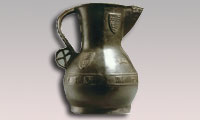Wenlok jug

TheWenlok jugorWenlock jugis a rare surviving example of an English bronze jug from the 15th century, with great significance for the study of bronze working in medieval England. Only two similar jugs are known in the UK. The Wenlok jug is the smallest of the three, but bears the earliest maker's mark for the English founder - possibly a bell founder - who cast it. The other examples are theAsante Ewer,which retains its lid and is held by theBritish Museumhaving been found atKumasiin theGold Coastin 1896 during theAnglo-Ashanti wars,and theRobinson jug,which was found in a farmhouse in Norfolk in the 1879 and is now in the collection of theVictoria & Albert Museum.All bear inscriptions in English and were made fromleaded bronze,an alloy of copper, tin and lead, cast in a two-part mould in a similar manner using bronze spacers to separate the inner and outer moulds, with similar decorative motifs.
The Wenlok jug stands 31.5 centimetres (12.4 in) high and weighs 6.1 kilograms (13 lb). It is decorated with the words "My Lord Wenlok", and several heraldic emblems, including theRoyal Arms of Englandused from 1340 to 1405, and thethree crownsofEast Angliaassociated withSt Edmund(who wasKing of East Anglia) andSt Etheldreda.Hinges indicate a lid was once present, but it is now missing. It is thought to have been made forWilliam Wenlock(d. 1391), Canon ofSt Paul's Cathedralfrom 1362,Archdeacon of Rochesterfrom 1376, and Canon of theKing's Chapel, Westminsterin 1381, who is buried atSt Mary's Church, Luton,or his great-nephewJohn Wenlock, 1st Baron Wenlock,whose brick-built manor houseSomeries Castleis near Luton.
By 1831 it was in the collection ofThomas William Fermor, 4th Earl of Pomfret,possibly acquired by antiquarianHenrietta Louisa Fermor.
The jug was sold byAlexander Fermor-Hesketh, 3rd Baron HeskethatSotheby'sin 2005 along with other articles fromEaston Nestonin Northamptonshire. It reached £568,000, six times the top auctioneer's estimate of £60,000 to £80,000. TheMetropolitan Museum of Artin New York tried to buy the jug from the buyer, but a temporary export ban in October 2005 allowedLuton Museumto raise £750,000 to match the price and acquire it instead, funded by £137,500 from theNational Art Collections Fund,£500,000 from theNational Heritage Memorial Fund,and donations from the Headley Trust, the Pilgrim Trust, theWorshipful Company of Founders,the Friends of Luton Museums, and others.
The jug was displayed in Luton atWardown Park Museumand then at the Stockwood Discovery Centre inStockwood Park.It was stolen from a high-security cabinet at Stockwood Discovery Centre on 12 May 2012. After appearing on the BBC'sCrimewatchprogramme, the jug was recovered inTadworth,Surrey in September 2012.
It has also been suggested[1]that all three ewers were made in, or near,Brugesduring the first week of July 1468, and given by theCharles the Bold,Count of Burgundy, to the travelling companions of his bride,Margaret of York(KingEdward IV's sister). Her companions were Sir Anthony Woodville (Asante Ewer), the Duchess of Norfolk (the Robinson Jug), and Lord John Wenlock (the Wenlock Jug). The English texts were devised by the new countess, and the out-of-date coat of arms were in the household of the count's aunt, who had married the Duke of Bedford in 1423. The three jugs/ewers would therefore be examples of mid-fifteenth century Burgundian workmanship.
References
[edit]- ^FRAY, Adrian F.;The Mystery of Lord Wenlock and His Glastonbury Treasure;Austen Macauley, 2016;ISBN978-1785544729.
- Art treasure auction raises £8.7m,BBC News, 20 May 2005,
- Jug goes on display in home town,BBC News, 26 May 2006
- Museum battles with Met over jug,BBC News, 21 February 2006
- Wenlok Jug stolen from Stockwood Discovery Centre,BBC News, 14 May 2012
- Stolen Wenlok Jug from Luton 'recovered in Surrey',BBC News, 25 September 2012
- Wenlok Jug returned to museum after theft,BBC News, 27 September 2012
- The Wenlok Jug,Friends of Luton Museums
- Wenlok jug,ArtFund
- Asante ewer,Richard II's treasure, The Institute of Historical Research and Royal Holloway, University of London, 2007
- Rare 15th Century find,The Founder Review, 2004-2007, review, p. VIII
- Asante Ewer,British Museum
- Robinson Jug,Victoria & Albert Museum
